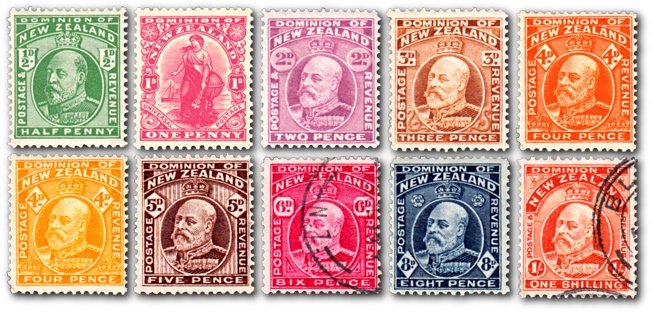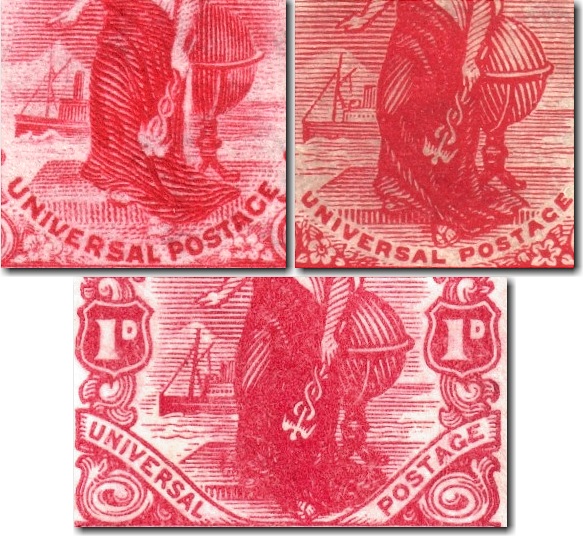
1909 King Edward VII
«previous next»

| Cat. | Mint Unhinged | Mint Hinged | Fine Used | |||||
| ½d | Green | 23a | $31.50 | $13.50 | $1.10 | |||
| 1d | Dominion | 23b | $9.00 | $3.60 | $1.00 | |||
| 2d | Mauve | 23c | $90.00 | $36.00 | $9.00 | |||
| 3d | Brown | 23d | $99.00 | $36.00 | $2.70 | |||
| 4d | Orange | 23e | $99.00 | $40.50 | $36.00 | |||
| 4d | Yellow | 23f | $90.00 | $40.50 | $27.00 | |||
| 5d | Brown | 23g | $90.00 | $31.50 | $3.15 | |||
| 6d | Red | 23h | $153.00 | $63.00 | $3.15 | |||
| 8d | Blue (from 1916) | 23i | $81.00 | $31.50 | $3.60 | |||
| 1/- | Orange | 23j | $360.00 | $135.00 | $16.20 | |||
| Set of 10 | 23k | $1,047.40 | $409.55 | $97.75 | ||||
| First Day Cover - 8 November 1909 | 23l | $0.00 | $0.00 | $2,700.00 | ||||
| … 1d (23b) | ||||||||
| First Day Cover - 8 November 1909 | 23m | $0.00 | $0.00 | $6,300.00 | ||||
| … Nine Stamps : ½d (23a), 2d (23c), 3d (23d), 4d (23e), 4d (23f), 5d (23g), 6d (23h), 8d (23i), 1/- (23j) | ||||||||
It is rather puzzling then that New Zealand stamps bearing the King's head were not issued until November 1909, and even then they were not distributed widely until stocks of the pictorials had been exhausted. Once issued, most values remained on sale until 1915, and the five penny and eight penny stamps were still in use in 1920, ten years after King Edward's death. The one penny dominion was still in use until 1926.
The Imperial Conference of 1907 granted the self-governing colonies of Canada, Australia, New Zealand and Newfoundland the status of Dominion. This recognized these territories as autonomous communities within the British Empire, and established them as equals to the United Kingdom, making them essentially independent members of the Commonwealth of Nations. In many ways, this issue was a celebration of New Zealand's new-found independence and "Dominion of New Zealand' appears proudly at the top of each stamp.
The progression of New Zealand from British colony to independent country has been an extremely drawn out and at many stages reluctant journey - often prompted by legislative changes from Westminster rather than Wellington:
1840 - The signing of the Treaty of Waitangi marked the beginning of organised British colonisation of New Zealand.
1852 - The British Parliament passed the New Zealand Constitution Act 1852 to grant the colony's settlers the right to self-governance in domestic matters. The New Zealand Parliament was still bound by a number of Acts of the British Parliament.
1869 - Creation of New Zealand flag.
1901 - New Zealand did not ratify the Australian Constitution, and rejected membership of the Australian Commonwealth
1907 - On the 26th of September the United Kingdom granted New Zealand "Dominion" status within the British empire. This date was declared Dominion Day. However, Westminster still retained control over New Zealand's foreign affairs and the military.
1919 - Prime Minister Bill Massey signed the Treaty of Versailles giving New Zealand membership of the League of Nations. This indicated that New Zealand had asserted a degree of control over foreign affairs. However, New Zealand signed along with other Dominions as part of a "British Empire Delegation" and all names were indented in a list following that of Britain
1921 - At the Imperial Conference British Prime Minister Lloyd George stated: "In recognition of their service and achievements during the war, the British Dominions have now been accepted fully into the comity of the nations of the whole world. They are signatories to the Treaty of Versailles and all other treaties of peace. They are members of the Assembly of the League of Nations, and their representatives have already attended meetings of the League. In other words, they have achieved full national status and they now stand beside the United Kingdom as equal partners in the dignities and responsibilities of the British Commonwealth. If there are any means by which that status can be rendered even more clear to their own communities and to the world at large, we shall be glad to have them put forward."
1926 - The Balfour Declaration declared the Dominions as autonomous Communities, equal and in no way subordinate in any aspect of their domestic or external affairs. For practical purposes this had the effect of acknowledging New Zealand's control over foreign policy and military.
1931 - The Statute of Westminster created the legal basis for independence established by the Balfour Declaration, but did not take effect until each Dominion chose to adopt it. It was prompted by nationalist elements in South Africa and the Irish Free State. Both Australia and New Zealand were hostile towards this development.
1939 - the Governor-General ceased to be Britain's High Commissioner to New Zealand - instead an independent officer was appointed. On the 3rd of September, New Zealand declared war on Germany at the same time as Britain - the declaration of war is normally regarded as an indication of sovereignty.
1944 - The New Zealand government announced the intention to adopt the Statute of Westminster. There was a strong outcry that this would weaken the British Empire in a time of need and the decision was deferred.
1947 - The Statute of Westminster was finally ratified by New Zealand as New Zealand legally accepted independence. The New Zealand Parliament accepted full legislative powers, extra-territorial control of the New Zealand military and legally separated the New Zealand Crown from the British Crown.
1949 - In accordance with the New Zealand Citizenship Act 1948, all New Zealanders became New Zealand citizens but remained British subjects.
1973 - Even during the 1950s and 1960s many New Zealanders still referred to Britain as 'home' but this attitude began to change when the United Kingdom joined the European Economic Community (EEC) in 1973. The vast majority of New Zealand's exports went to Britain at that time, and joining the EEC forced Britain to sever these trade agreements which pushed New Zealand into economic recession.
1974 - The Royal Titles Act formally recognized Queen Elizabeth II as the "Queen of New Zealand" thus recognising New Zealand as an independent Commonwealth Realm.
For cost reasons, the half penny and penny stamps were surface printed in sheets of 240 and the remaining stamps were recess printed in sheets of 120.

The 1909 King Edward VII 'penny dominion' (bottom) retained a similar design to the 1907 Redrawn Pictorials penny (top right) with 'Dominion of' added at the top of the stamp and 'universal postage' appearing on a scroll at the bottom of the stamp. Both the 1909 King Edward VII dominion and 1907 Redrawn Pictorials penny stamps have diagonal shading lines on the globe behind the figure of Zealandia. The 1901 Penny Universal (top left) has vertical shading on the globe. The wake at the bow of the steamer is also far more impressive on the 1901 Penny Universal.
The 8d Blue stamp was issued in 1916 to cover an increase in postal rates for telegrams and parcels.
Bibliography
The Postage Stamps of New Zealand (Volume I)
Edited by R. J. G. Collins and H. T. M. Fathers B.A. B.Sc.
Published 1938 by The Philatelic Society of New Zealand Incorporated
Pages 269 - 292, 575 - 577
The Postage Stamps of New Zealand Volume II
Edited by R. J. G. Collins FRPSNZ and C. W. Watts FRPSNZ
Published 1950 by The Royal Philatelic Society of New Zealand Incorporated
Pages 233 - 235, 311
The Postage Stamps of New Zealand Volume IV
Edited by R. J. G. Collins FRPSNZ and C.W. Watts FRPSNZ
Published 1960 by The Royal Philatelic Society of New Zealand Incorporated
Pages 376 - 377
The Postage Stamps of New Zealand Volume VI
Edited by D. E. G. Naish FRPSNZ and K. J. McNaught FRPSNZ FRPSL
Publsihed 1975 by The Royal Philatelic Society of New Zealand Incorporated
Pages 19 - 21, 358
The Postage Stamps of New Zealand Volume VIII
Edited by B. G. Vincent FRPSNZ
Published 1998 by The Royal Philatelic Society of New Zealand Incorporated (ISSN 0-9597883-1-X)
Pages 708 - 709
Catalogue ·
1908 ·
1909 ·
1910 ·
Definitives ·
The Royal Family
Order Form · Currency Converter · Privacy Policy
What to Expect · Contact Us · Links
Order Form · Currency Converter · Privacy Policy
What to Expect · Contact Us · Links
Wishing you a Merry Christmas and a Happy and Prosperous New Year
This page was last updated on 28 Dec 2025
All content and images copyright © 2008 - 2025 StampsNZ
This page was last updated on 28 Dec 2025
All content and images copyright © 2008 - 2025 StampsNZ